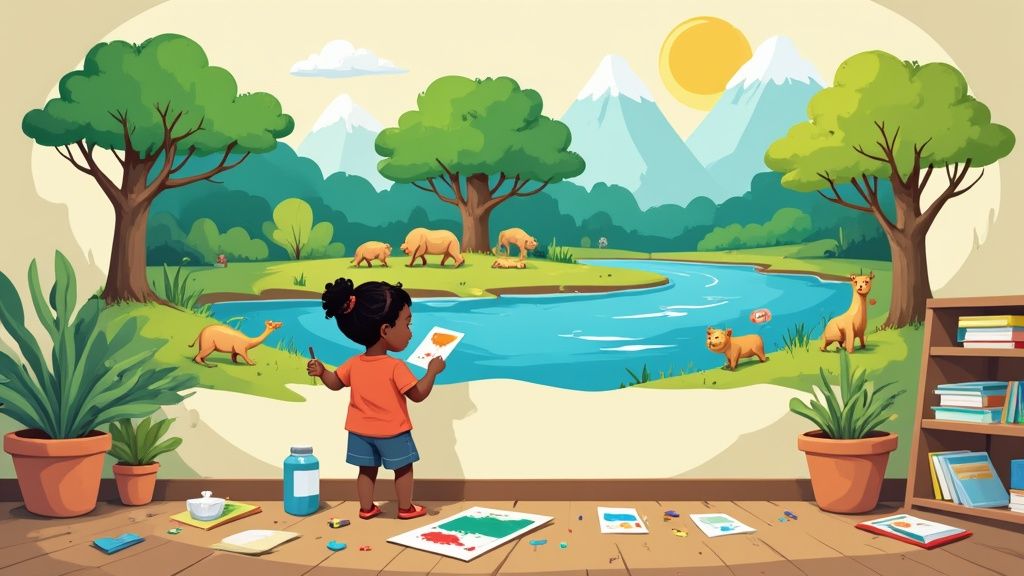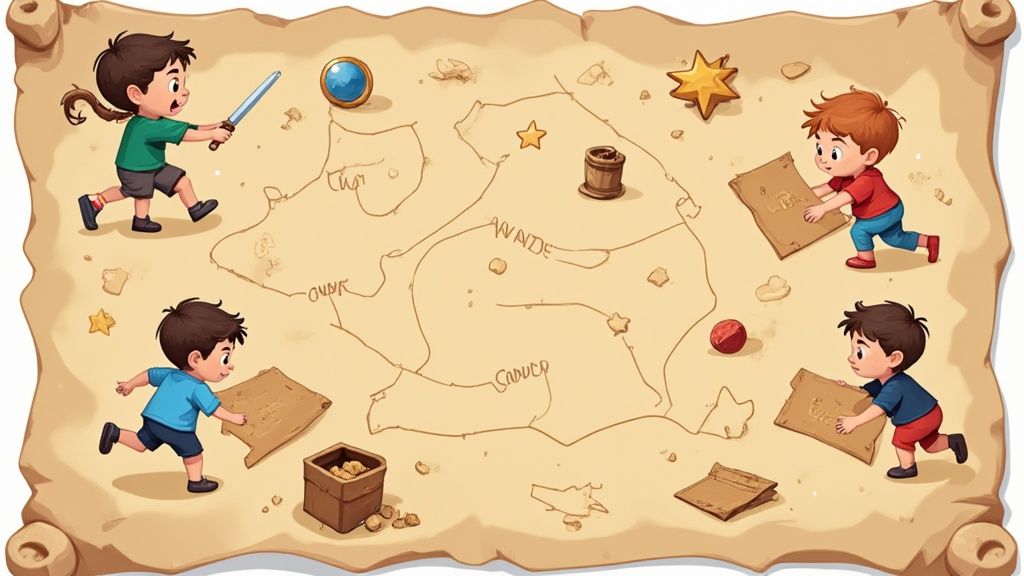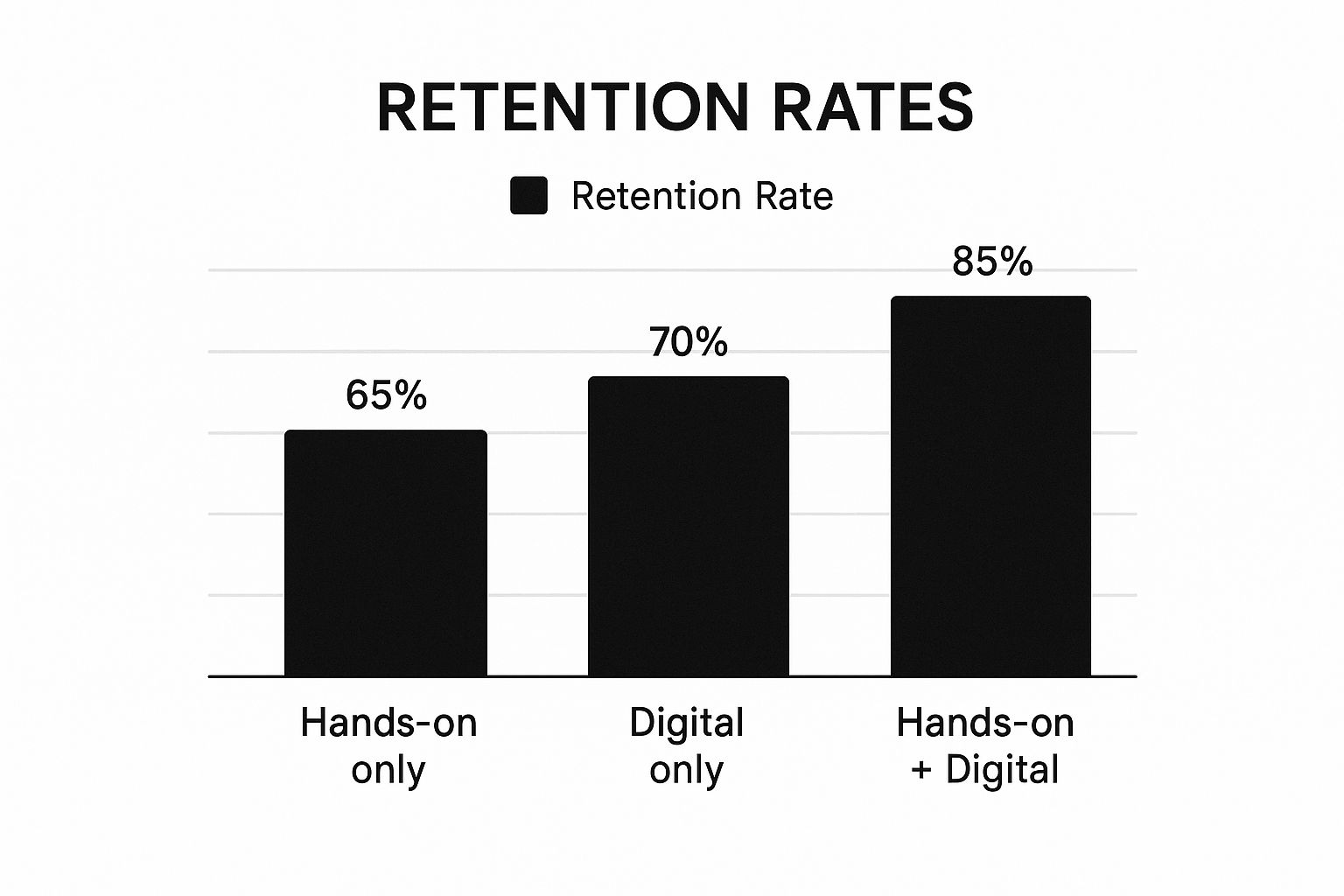The easiest way to make learning stick is to stop treating it like work. When we reframe a lesson as a game or a hands-on creative project, we're not just making it more entertaining; we're connecting information to a positive experience. This simple shift makes the material far more memorable and genuinely motivating for kids.
Why Joyful Learning Is a Game Changer
Let's face it, trying to get a child to memorize a list of facts is often a losing battle. But what if learning felt less like a chore and more like an adventure? This idea of "joyful learning" isn't just about making things easy; it’s a powerful strategy that taps into how our brains are wired to learn best.

When we feel happy and engaged, our brains are primed for critical thinking and better memory recall. As a child's stress levels drop, their mind opens up, ready to soak in new information. Just think of the difference between having them read a dry textbook chapter on rainforests versus letting them create a vibrant, colorful mural of the Amazon. Actionable insight: Let them color a sloth in its habitat. While they choose shades of green for the leaves and brown for the branches, talk about why sloths move so slowly and what they eat. The second option builds a much stronger, personal connection to the subject.
The Science Behind Fun and Retention
There’s real science at play here. When we enjoy an activity, our brains release dopamine, the neurotransmitter linked to pleasure and reward. This chemical basically sends a signal that says, "Pay attention! This is good stuff worth remembering." That emotional hook is what turns a passive lesson into an active, unforgettable experience.
This isn't just a hunch; the numbers prove it. A huge Gallup study involving over 30,000 students revealed that focusing on engagement made students feel more prepared for their future and even report higher life satisfaction. The research demonstrated that making learning fun can boost classroom engagement by a staggering 6 to 14 percentage points. You can explore the full Gallup student poll findings to see just how significant the impact is.
The big takeaway is that making learning fun isn't a fluffy add-on or a distraction from "real" education. It is the foundation for raising curious, confident, and lifelong learners.
To put this into practice, it's helpful to remember a few core ideas that can turn any lesson into an engaging experience. These principles help ensure that the fun has a purpose and directly supports the learning goals.
Core Principles for Engaging Lessons
| Principle | What It Means for Learning | Actionable Example |
|---|---|---|
| Make It Active | Kids learn by doing, not just by listening. Get them moving and interacting with the material. | Instead of a worksheet on shapes, have a "shape scavenger hunt" around the room or playground. "Find three circles!" |
| Give Them Choice | Allowing students to have a say in their learning fosters ownership and boosts motivation. | When studying animals, let them choose which habitat to research and present on using colors and drawings. |
| Connect to Their World | Relate new concepts to things they already know and care about. | Use their favorite characters to explain math problems (e.g., "If Spider-Man has 5 webs and gets 3 more..."). |
| Embrace Creativity | Provide open-ended opportunities for them to express their understanding in unique ways. | After reading a story, ask them to color a scene that wasn't in the book or design a new cover with their own color scheme. |
By keeping these principles in mind, you can start to see opportunities everywhere to make learning more meaningful and, most importantly, more fun.
Practical Benefits of Engaged Learning
When we shift toward a more enjoyable way of teaching, the advantages become clear pretty quickly for both kids and adults. We're essentially building an environment where curiosity can flourish.
- Improved Memory: Joyful, hands-on experiences are simply easier to remember than a list of dry facts.
- Increased Motivation: Kids are much more likely to participate when they're actually looking forward to the activity.
- Deeper Understanding: Fun activities often require children to apply what they've learned, leading to a much more solid grasp of the topic.
Weaving Color Into Every Lesson
Most of us think of coloring as a simple way to keep kids busy on a rainy day. But what if I told you it's one of the most effective teaching tools you have? When you bring coloring into subjects like math, science, or even grammar, you’re doing more than just making it fun. You're giving kids a hands-on way to connect with abstract ideas, which helps lock them into memory.
It's an incredibly simple and affordable way to make learning stick.

The real magic happens when you shift from just coloring pictures to coloring with a purpose. Instead of just handing over a generic sheet, you frame the activity around a specific learning goal. Suddenly, a simple pastime becomes a focused, engaging lesson.
How to Make Core Subjects More Colorful
You can bring this technique into almost any subject. The secret is to tie the physical act of coloring directly to the information you want a child to absorb. This forges a much stronger mental link than listening to a lecture or reading a textbook ever could.
Here are a few actionable ideas:
Science That Pops: Forget dry diagrams. Hand out a cross-section of a volcano and ask them to color the magma chamber a fiery orange, the ash cloud a stormy gray, and the Earth's crust a solid brown. As they pick each color, they're actively engaging with the vocabulary and structure in a way they'll remember. Coloring Advice: Encourage them to use different pressures with their crayons to create texture—a light gray for smoke, a darker gray for rock.
Math They'll Want to Do: Who loves multiplication drills? Almost no one. Try a color-by-number worksheet where the answers to equations reveal a hidden picture. Figuring out that 7 x 6 means you get to color a section blue is far more motivating than just writing "42" on a line. Coloring Advice: Suggest they outline the section first before filling it in to practice fine motor skills and stay within the lines.
Grammar You Can See: Abstract grammar rules can be tough. Make them tangible by having kids color-code sentences. They could color all the nouns green, the verbs orange, and the adjectives purple. This visual sorting exercise helps them internalize sentence structure without even realizing it.
A Few Tips for Making It Work
A little bit of planning can turn a good coloring activity into a great one. These pointers help keep the lesson on track while making sure the fun doesn't get lost.
First off, try using a limited color palette. If you’re teaching the planets, don't overwhelm them with a 64-crayon box. Just pull out the essentials: red for Mars, a swirl of blue and green for Earth, pale yellow for Jupiter. This simple constraint forces them to match the correct color to the correct planet, reinforcing the lesson.
Another fantastic technique is creating "story maps" together. After reading a book, give them a simple template with boxes for the main characters, the setting, and a few key plot points. As you talk through the story, they can draw and color in each box, creating a beautiful visual summary that they made themselves.
It's never about creating a perfect masterpiece. The goal is to use the simple, physical act of coloring to build mental bridges, making complex information easier to understand and recall.
If you need a little inspiration, you can find a huge variety of educational and fun coloring pages for kids online that are easy to adapt for any subject you're teaching. They're a perfect jumping-off point for your next creative lesson.
Make Learning an Adventure with Gamified Quests
What if you could harness a child's natural love for play and channel it directly into their lessons? That’s the simple but powerful idea behind gamification. It’s not about screens or complicated software; it’s about borrowing the best parts of games—like challenges, points, and exciting rewards—and weaving them into everyday learning activities.
This little shift in perspective can transform a dull worksheet into an epic quest.

Think about a history lesson. Instead of just reading about ancient Egypt, you could create a "Pharaoh's Tomb" mission. Each Colortada coloring page of a pyramid or hieroglyph holds a clue. As your child colors, they "unlock" a new fact, bringing them one step closer to solving the final puzzle. They aren't just memorizing dates; they're becoming history detectives.
This method gives kids a tangible sense of progress, which is a huge motivator. They're not just "doing homework"—they're conquering challenges and earning their way to the next level. For a deeper dive, exploring various gamification for eLearning strategies can provide even more inspiration.
How to Build Your First Learning Quest
Getting started is way easier than you might think. The key is to define a "mission objective" and then chop it up into smaller, bite-sized tasks. These mini-victories are what keep kids hooked.
Let's try a "Vocabulary Voyager" challenge. For every new word they learn and use correctly, they get to color in a section of a treasure map. Watching the map fill up with color gives them a fantastic visual of how far they've come.
Here's an actionable framework to get you started:
- Set Clear Rules: Make sure they know exactly what they need to do to win points or unlock the next part of the adventure. For example: "Color three vocabulary words correctly to earn one map piece." Simplicity is your friend here.
- Use a Simple Point System: Award points for things like correctly spelling a word, solving a math problem, or coloring a section neatly. Track points on a simple chart with stickers.
- Offer Rewards That Matter: Prizes don’t have to be candy or toys. The reward could be choosing the next book to read together or getting 10 extra minutes of free-draw time.
Why This Approach Clicks with Kids
Gamification works because it taps directly into the brain's natural reward system. It offers instant feedback and a clear sense of direction, which cuts down on the frustration that often comes with tough subjects.
When you frame a lesson as a quest, you’re teaching more than just the subject matter. You’re building resilience, nurturing problem-solving skills, and showing them that discovery itself is exciting.
This isn’t just a neat trick; it's a proven educational approach. Interactive, play-based learning is making a huge difference in classrooms all over the world, helping kids stay engaged and eager to learn.
Ready to add another layer of fun? Our guide on https://www.colortada.com/blog/post/animated-coloring-pages has some fantastic ideas for making those coloring pages pop right off the page, taking your learning quests to a whole new level.
Blend Hands-On Fun with Smart Technology
Let's be honest, technology can feel more like a distraction than a teaching tool. But what if we used it to build on the physical, hands-on activities kids already love? The goal isn't to replace crayons with a stylus, but to merge the best of both worlds for a learning experience that really sticks.
Think about it this way: your child just finished coloring a fantastic character from a Colortada page. Instead of it just going on the fridge, what's next? You could use a simple, free animation app on your phone to make their drawing "talk." Suddenly, they’re not just looking at their art; they’re recording a voiceover, telling a story, or explaining a concept as that character. Their creation just came to life.
Creating an Interactive Learning Loop
When you do this, you create a powerful learning loop. The hands-on coloring sparks a digital adventure, and the fun they have on the screen makes them want to go back and create even more with their hands. It’s a fantastic cycle that reinforces what they're learning from different angles.
Here are a few practical ways to try this:
Make it a Game: After coloring a diagram of the water cycle, snap a picture and pop it into a free tool like Kahoot!. You can build a super quick quiz using their artwork. Ask simple questions like, "What part of the cycle did you color blue?" This instantly turns their masterpiece into a fun, interactive review game.
Spark Their Imagination: Finished coloring a dragon? Use an AI assistant to generate a fun story starter about that specific dragon. This can be the perfect jump-start for a creative writing session, all inspired by the picture they just colored. Actionable insight: Prompt the AI with, "Write a 3-sentence story starter for a 7-year-old about a friendly green and purple dragon who just learned to fly."
This mix of physical and digital play isn’t just about making learning more fun—it's about making it stick. Technology becomes the tool that deepens the connection to what they just created and learned by hand.
Don't just take my word for it. The research shows that combining these two approaches makes a real difference in how well kids remember things.

As you can see, that combined approach gives a huge boost to learning retention. Teachers are catching on, too. Right now, about 40% of educators are using AI tools to help create their own lesson plans and activities. If you're curious, you can read more about these global education insights and see how this blend is shaping modern classrooms.
Your Sample Weekly Fun-Learning Blueprint
https://www.youtube.com/embed/PU6HSZEBQeQ
Alright, let's put these ideas into practice. Knowing how to make learning fun is one thing, but having a solid plan is what makes it a consistent reality. Think of what follows not as a rigid set of rules, but as a flexible starting point for your week—one that mixes coloring, games, and a little bit of tech into a routine your kids will actually look forward to.
The goal here is to build a predictable rhythm that keeps energy high and transforms learning from a "have to" into a "get to." Assigning a playful theme to each day is a simple but powerful way to build that anticipation.
Designing Your Themed Week
Let's imagine what this could look like. Each day has its own little mission, pairing a hands-on coloring activity with a game or app that reinforces the same concept. It’s all about creating connections.
- Math Mission Monday: Start the week by tackling some color-by-number puzzles. Once they’ve solved the problems and colored in the picture, snap a photo with your phone and use a simple app to play a timed "spot the number" game. It’s a great way to double down on number recognition.
- Time Traveler Tuesday: Dive into history by coloring a detailed map of ancient Egypt or a fierce Viking longship. Afterward, find a quick, engaging video clip on YouTube about that exact topic. Seeing the thing they just colored come to life makes the history stick.
- Word Weaver Wednesday: This is perfect for building vocabulary. Grab some blank cards and create your own color-coded flashcards—maybe blue for verbs and green for nouns. Then, use them to play a fast-paced matching game or see who can build the silliest sentences.
The real aim isn't to create a strict, minute-by-minute schedule. It's about establishing a reliable rhythm for fun. A predictable structure helps kids feel secure and genuinely excited for what’s coming next, which makes them far more open to learning.
Sample Weekly Fun-Learning Schedule
To give you a clearer picture, here’s a sample table you can adapt. It’s just a template to show how you can structure a week of engaging activities that blend coloring with other fun learning methods.
| Day of the Week | Theme | Primary Coloring Activity | Supporting Game or Tech Activity |
|---|---|---|---|
| Monday | Math Monsters | Color-by-Number monster sheets | "Monster Math" app for drills |
| Tuesday | Animal Kingdom | Coloring pages of different habitats | Watch a short nature documentary |
| Wednesday | Story Starters | Color characters and settings | Use the colored pictures to create a story |
| Thursday | Science Explorers | Coloring the solar system | Interactive star-gazing app |
| Friday | Fun Finale! | Free-choice coloring pages | Family trivia game based on the week |
This kind of schedule provides just enough structure to be helpful without stifling spontaneity.
Wrapping Up the Week with Fun
Finishing the week on a high note is just as important as starting it strong. This is your chance to review everything you’ve covered in a low-pressure, celebratory way.
For Tech-Up Thursday, why not create a quick digital quiz using the colored pages from earlier in the week as the visuals for your questions? Then, you can close it all out with Fun Finale Friday. This could be a collaborative review game, like a family trivia match or a "build a story" session where you use all the characters and concepts from the week.
If you need more ideas on how to structure your days, these fantastic homeschool activities for kindergarten are a goldmine of inspiration that can easily be adapted for different ages.
Got Questions? We’ve Got Answers About Fun Learning
It’s completely normal to have a few questions when you start bringing more playful, creative methods into your learning routine. Parents and teachers often wonder about the practical side of things—how to keep kids on track without sacrificing the educational goals. Let's tackle some of the most common concerns I hear.
How Do I Make "Boring" Subjects Fun?
The trick is to make abstract concepts tangible and visual. Think about a subject like grammar. Instead of a dry worksheet, give kids a story page and a couple of highlighters.
Their mission? Color-code the parts of speech!
- Make all the verbs pop in yellow.
- Highlight all the adjectives in blue.
- Circle the nouns in green.
Coloring Advice: Using transparent highlighters is key here so you can still read the words underneath. For younger kids, you can simply have them color a block next to the word instead of over it. This makes grammar feel like a treasure hunt on a page and turns a passive lesson into an active, hands-on discovery.
What If My Child Gets Easily Distracted?
This is a big one, but it’s manageable. The key is to set a clear, simple goal before the fun begins. Frame it as a mini-mission.
For example, you could say, "Okay, our mission for this coloring page is to learn five new vocabulary words about the ocean." The coloring becomes the tool to complete the mission, not just a random activity.
After they're done, keep it light and playful. A quick check-in like, "Can you point to the anemone you colored orange?" reinforces the learning without feeling like a quiz.
A simple check-in connects the joy of the activity directly to the pride of learning something new. It shows them that the fun had a purpose, which is a huge motivator.
For a deeper dive into this, you can find many proven strategies to make learning fun that help build that crucial foundation.
How Do I Balance This With Traditional Schoolwork?
Think integration, not addition. You don’t need to find extra hours in the day. It's about smart swaps.
Instead of a standard phonics worksheet, try a 15-minute coloring activity that covers the exact same letter sounds. Ditch a rote memorization drill for a 10-minute quiz game where they color the right answer.
Start small. Actionable insight: This week, swap just one worksheet. Instead of a math facts sheet, use a color-by-number page that practices the same skill. You'll probably find that engagement shoots up so much that learning actually becomes more efficient, helping you hit your goals in less time.
Ready to fill your week with creative and educational fun? Colortada offers thousands of high-quality, printable coloring pages perfect for any subject or interest. Visit us at https://www.colortada.com to download your first adventure

